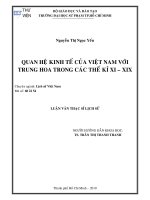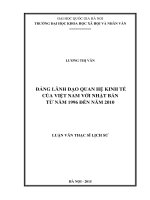Quản trị kinh doanh luôn là một trong những ngành hấp dẫn các bạn trẻ năng động, đặc biệt trong xu thế hội nhập kinh tế Quốc tế của Việt Nam những năm gần đây. Việc tìm hiểu rõ về ngành Quản trị kinh doanh giúp bạn định hướng nghề nghiệp tốt hơn trước kh
Bạn đang xem bản rút gọn của tài liệu. Xem và tải ngay bản đầy đủ của tài liệu tại đây (970.78 KB, 13 trang )
Chapter 11
Developing Leadership Diversity
1
Chapter Objectives
Apply an awareness of the dimensions of diversity
and multicultural issues in your everyday life.
Encourage and support diversity to meet
organizational needs.
Consider the role of cultural values and attitudes in
determining how to deal with employees from
different cultures or ethnic backgrounds.
Reduce the difficulties faced by minorities in
organizations.
Break down your personal barriers that may stand
in the way of enhancing your level of diversity
awareness and appreciation.
2
Diversity
Workforce Diversity
A workforce made up of people with different
human qualities or who belong to various
cultural groups
Diversity
Differences among people in terms of age,
ethnicity, gender, race, or other dimensions
3
Interactive Leadership
A leadership style in which people
develop personal relationships with
followers, share power and
information, empower employees,
and strive to enhance others’ feelings
of self-worth
4
Social Value Systems
Power Distance
How much people accept equality in power; high power
distance reflects an acceptance of power inequality
among institutions, organizations, and individuals. Low
power distance means people expect equality in power
Uncertainty Avoidance
The degree to which members of a society feel
uncomfortable with uncertainty and ambiguity and thus
support beliefs and behaviors that promise certainty and
conformity
Individualism
A value for a loosely knit social framework in which
individuals are expected to take care of themselves
5
Social Value Systems (contd.)
Collectivism
A preference for a tightly knit social framework in which
people look out for one another and organizations
protect their members’ interests
Masculinity
A preference for achievement, heroism, assertiveness,
work centrality, and material success
Femininity
A preference for relationships, cooperation, group
decision making, and quality of life
6
Ex. 11.3 Rank Orderings of 10
Countries Along Four Dimensions
of National Value Systems (adapted)
Country
Australia
Costa Rica
France
India
Japan
Mexico
Sweden
Thailand
United States
Power
Uncertainty
Individualism
Masculinity
7
8
3
2
5
1
10
4
6
7
2 (tie)
2 (tie)
9
1
4
10
6
8
2
10
4
6
7
8
3
9
1
5
9
7
6
1
2
10
8
4
7
Ethnocentrism
The belief that one’s own
culture and subculture are
inherently superior to other
cultures
8
Biculturalism
The sociocultural skills
and attitudes used by
racial minorities as they
move back and forth
between the dominant
culture and their own
ethnic or racial culture
9
Glass Ceiling
An invisible barrier that
separates women and minorities
from top leadership positions
10
Ex. 11.5 Evolution of Organizational
Diversity Awareness and Action
Stage 5
Diversity is inherent in the culture
Gender and color-blind
Stage 4
Diversity as “Moral Imperative”
Top-level commitment to valuing
diversity
Stage 3
Diversity as a competitive
weapon
Effort to recruit/retain minorities
Stage 2
“We need to react”
Recognition of barriers minorities
face
Stage 1
Meet legal requirements
Diversity as a “problem”
11
Diversity Awareness Training
Training that helps employees
become aware of their own
cultural boundaries, their
prejudices and stereotypes, so
that they can learn to work
together successfully
12
Ex. 11.6 Stages of
Personal Diversity
Awareness
Highest Level of Awareness
Integration
Multicultural attitude – enables one to
integrate differences and adapt both
cognitively and behaviorally
Adaptation
•Able to empathize with those of other
cultures
•Able to shift from one cultural perspective to
another
Acceptance
•Accepts behavioral differences and
underlying differences in values
•Recognizes validity of other ways of thinking
and perceiving the world
Minimizing Differences
•Hides or trivializes cultural differences
•Focuses on similarities among all
peoples
Defense
Perceives threat against one’s comfortable
worldview
Uses negative stereotyping
Assumes own culture superior
Lowest Level of Awareness
13









